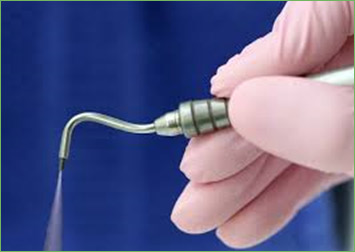Air Abrasion
Dental Care Without the Drill

Air abrasion is a drill-less technique that is being used by some dentists to remove early, small areas of tooth decay and to perform other procedures.
How Does Air Abrasion Work?
During air abrasion, an instrument that works like a mini sandblaster is used to spray away decay. During air abrasion, a fine stream of particles is aimed at the stained or decayed portion of the tooth. These particles are made of silica, aluminum oxide, or a baking soda mixture and are propelled toward the tooth surface by compressed air or a gas that runs through the dental handpiece. Small particles of decay on the tooth surface are removed as the stream of particles strikes them. The particles of decay are then "suctioned" away through a thin tube.
Is Air Abrasion Safe?
Yes, air abrasion is safe. The only precautions needed before air abrasion are protective eye wear (to prevent eye irritation from the spray) and the use of a rubber dam (a rubber sheet that fits around teeth) or protective resin applied to nearby teeth and gums to protect areas of the mouth that aren't being treated. The suctioning of particles also prevents them from being breathed into the lungs.
What Are the Advantages of Air Abrasion?
Compared with the traditional drilling method, the advantages of air abrasion are many and include the following:
- Air abrasion generates no heat, pressure, or vibration.
- Air abrasion sometimes reduces the need for anesthesia, particularly if the cavity is shallow.
- Air abrasion leaves more of the healthy tooth tissue behind.
- Air abrasion reduces the risk of fracturing and chipping of the tooth, which some dentists believe can affect the life span of the filling.
- The procedure is relatively simple, although it may take longer than traditional drilling.
What Are the Disadvantages?
- Air abrasion is a little messy with the sand/water mixture.
- Air abrasion is not recommended for deep cavities (those close to the tooth's pulp) or for cavities in between teeth. It is best suited for removing small cavities that form early on the outer or chewing surface of teeth.
- Crowns, onlays, and inlays cannot be prepared using air abrasion.
Who Are the Best Candidates for Air Abrasion Procedures?
Air abrasion is ideal for use in children and others who are fearful and have minimal decay.
What Other Types of Procedures Are Performed With Air Abrasion?
Air abrasion can also be used to:
- Remove some old composite restorations, but not metallic restorations such as silver amalgam fillings
- Prepare a tooth surface for bonding or sealants
- Remove superficial stains and tooth discolorations


